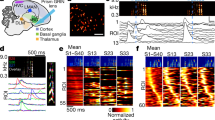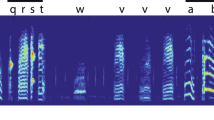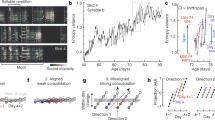Abstract
Significant trial-by-trial variation persists even in the most practiced skills. One prevalent view is that such variation is simply ‘noise’ that the nervous system is unable to control or that remains below threshold for behavioural relevance1,2,3. An alternative hypothesis is that such variation enables trial-and-error learning, in which the motor system generates variation and differentially retains behaviours that give rise to better outcomes. Here we test the latter possibility for adult bengalese finch song. Adult birdsong is a complex, learned motor skill that is produced in a highly stereotyped fashion from one rendition to the next4,5. Nevertheless, there is subtle trial-by-trial variation even in stable, ‘crystallized’ adult song6,7,8. We used a computerized system to monitor small natural variations in the pitch of targeted song elements and deliver real-time auditory disruption to a subset of those variations. Birds rapidly shifted the pitch of their vocalizations in an adaptive fashion to avoid disruption. These vocal changes were precisely restricted to the targeted features of song. Hence, birds were able to learn effectively by associating small variations in their vocal behaviour with differential outcomes. Such a process could help to maintain stable, learned song despite changes to the vocal control system arising from ageing or injury. More generally, our results suggest that residual variability in well learned skills is not entirely noise but rather reflects meaningful motor exploration that can support continuous learning and optimization of performance.
This is a preview of subscription content, access via your institution
Access options
Subscribe to this journal
Receive 51 print issues and online access
$199.00 per year
only $3.90 per issue
Buy this article
- Purchase on Springer Link
- Instant access to full article PDF
Prices may be subject to local taxes which are calculated during checkout





Similar content being viewed by others
References
Beers, R. J. V., Baraduc, P. & Wolpert, D. M. Role of uncertainty in sensorimotor control. Phil. Trans. R. Soc. Lond. B 357, 1137–1145 (2002)
Todorov, E. Optimality principles in sensorimotor control. Nature Neurosci. 7, 907–915 (2004)
Harris, C. M. & Wolpert, D. M. Signal-dependent noise determines motor planning. Nature 394, 780–784 (1998)
Konishi, M. Birdsong: From behavior to neuron. Annu. Rev. Neurosci. 8, 125–170 (1985)
Deregnaucourt, S. et al. How sleep affects the developmental learning of bird song. Nature 433, 710–716 (2005)
Sossinka, R. & Bohner, J. Song types in the zebra finch Poephila guttata castanotis. Z. Tierpsychol. 53, 123–132 (1980)
Kao, M. H., Doupe, A. J. & Brainard, M. S. Contributions of an avian basal ganglia-forebrain circuit to real-time modulation of song. Nature 433, 638–643 (2005)
Kao, M. H. & Brainard, M. S. Lesions of an avian basal ganglia circuit prevent context-dependent changes to song variability. J. Neurophysiol. 96, 1441–1455 (2006)
Doupe, A. J. & Kuhl, P. K. Birdsong and human speech: common themes and mechanisms. Annu. Rev. Neurosci. 22, 567–631 (1999)
Nordeen, K. W. & Nordeen, E. J. Auditory feedback is necessary for the maintenance of stereotyped song in adult zebra finches. Behav. Neural Biol. 57, 58–66 (1992)
Okanoya, K. & Yamaguchi, A. Adult Bengalese finches (Lonchura striata var. domestica) require real-time auditory feedback to produce normal song syntax. J. Neurobiol. 33, 343–356 (1997)
Woolley, S. M. & Rubel, E. W. Bengalese finches Lonchura Striata domestica depend upon auditory feedback for the maintenance of adult song. J. Neurosci. 17, 6380–6390 (1997)
Leonardo, A. & Konishi, M. Decrystallization of adult birdsong by perturbation of auditory feedback. Nature 399, 466–470 (1999)
Zevin, J. D., Seidenberg, M. S. & Bottjer, S. W. Limits on reacquisition of song in adult zebra finches exposed to white noise. J. Neurosci. 24, 5849–5862 (2004)
Sutton, R. S. & Barto, A. G. Reinforcement Learning: An Introduction (MIT Press, Cambridge, Massachusetts, 1998)
Doya, K. & Sejnowski, T. in The New Cognitive Neurosciences (ed. Gazzaniga, M.) 469–482 (MIT Press, Cambridge, Massachusetts, 2000)
Troyer, T. & Doupe, A. J. An associational model of birdsong sensorimotor learning. I. Efference copy and the learning of song syllables. J. Neurophys. 84, 1204–1223 (2000)
Fiete, I. R., Fee, M. S. & Seung, H. S. Model of birdsong learning based on gradient estimation by dynamic perturbation of neural conductances. J. Neurophys. 98, 2038–2057 (2007)
Olveczky, B. P., Andalman, A. S. & Fee, M. S. Vocal experimentation in the juvenile songbird requires a basal ganglia circuit. PLoS Biol. 3, e153 (2005)
Hessler, N. A. & Doupe, A. J. Social context modulates singing-related neural activity in the songbird forebrain. Nature Neurosci. 2, 209–211 (1999)
Bottjer, S. W., Miesner, E. A. & Arnold, A. P. Forebrain lesions disrupt development but not maintenance of song in passerine birds. Science 224, 901–903 (1984)
Scharff, C. & Nottebohm, F. A comparative study of the behavioral deficits following lesions of various parts of the zebra finch song system: implications for vocal learning. J. Neurosci. 11, 2896–2913 (1991)
Amir, O., Amir, N. & Kishon-Rabin, L. The effect of superior auditory skills on vocal accuracy. J. Acoust. Soc. Am. 113, 1102–1108 (2003)
Sundberg, J., Prame, E. & Iwarsson, J. in Vocal Fold Physiology, Controlling Complexity and Chaos (eds Davis, P. & Fletcher, N.) 291–306 (Singular Publishing Group, San Diego, 1996)
Dent, M. L., Dooling, R. J. & Pierce, A. S. Frequency discrimination in budgerigars (Melopsittacus undulatus): Effects of tone duration and tonal context. J. Acoust. Soc. Am. 107, 2657–2664 (2000)
Fiete, I. R., Hahnloser, R. H., Fee, M. S. & Seung, H. S. Temporal sparseness of the premotor drive is important for rapid learning in a neural network model of birdsong. J. Neurophysiol. 92, 2274–2282 (2004)
Sakata, J. T. & Brainard, M. S. Real-time contributions of auditory feedback to avian vocal motor control. J. Neurosci. 26, 9619–9628 (2006)
Held, R., Efstathiou, A. & Greene, M. Adaptation to displaced and delayed visual feedback from the hand. J. Exp. Psychol. 72, 887–891 (1966)
Churchland, M. M., Afshar, A. & Shenoy, K. V. A central source of movement variability. Neuron 52, 1085–1096 (2006)
Churchland, M. M., Santhanam, G. & Shenoy, K. V. Preparatory activity in premotor and motor cortex reflects the speed of the upcoming reach. J. Neurophysiol. 96, 3130–3146 (2006)
Leonardo, A. Experimental test of the birdsong error-correction model. Proc. Natl Acad. Sci. USA 101, 16935–16940 (2004)
Kozhevnikov, A. & Fee, M. S. Singing-related activity of identified HVC neurons in the zebra finch. J. Neurophysiol. 97, 4271–4283 (2007)
Acknowledgements
We thank A. Doupe, L. Frank, T. Warren, M. Wohlgemuth, S. Sober, J. Sakata, C. Hampton and J. Wong for comments. This work was supported by an NIDCD NRSA postdoctoral fellowship and the Sloan-Swartz Foundation (E.C.T.) and by an NIDCD R01 award, an NIMH Conte Center for Neuroscience Research award and a McKnight Foundation Scholars Award (M.S.B).
Author Contributions E.C.T. performed the experiments and analysis; E.C.T. and M.S.B. designed the experiments and wrote the manuscript.
Author information
Authors and Affiliations
Corresponding author
Supplementary information
Supplementary Information
This file contains Supplementary Notes with Supplementary Figures S1-S3 showing: details of differential reinforcement; relationship between baseline variation and capacity for adaptive change and how non-contingent feedback did not alter song. (PDF 254 kb)
Supplementary Audio 1
This file contains Supplementary Audio 1 demonstrating the stereotypy of normal adult Bengalese finch song. Three separate songs are played corresponding to the spectrograms of Figure 1a. (WAV 310 kb)
Supplementary Video 1
This file contains Supplementary Video 1 demonstrating the salience of changes driven by progressively increasing the reinforcement threshold. Points and sounds reflect pitch of 20 randomly selected syllables from each of 2 days of baseline data and 13 days of differential reinforcement. Blue line indicates reinforcement threshold. Data from experiment of Figure 5a. (MOV 454 kb)
Rights and permissions
About this article
Cite this article
Tumer, E., Brainard, M. Performance variability enables adaptive plasticity of ‘crystallized’ adult birdsong. Nature 450, 1240–1244 (2007). https://doi.org/10.1038/nature06390
Received:
Accepted:
Issue Date:
DOI: https://doi.org/10.1038/nature06390
This article is cited by
-
Dopaminergic error signals retune to social feedback during courtship
Nature (2023)
-
Recruit-aged adults may preferentially weight task goals over deleterious cost functions during short duration loaded and imposed gait tasks
Scientific Reports (2023)
-
Dopamine facilitates the translation of physical exertion into assessments of effort
npj Parkinson's Disease (2023)
-
Transition from predictable to variable motor cortex and striatal ensemble patterning during behavioral exploration
Nature Communications (2022)
-
The online and offline effects of changing movement timing variability during training on a finger-opposition task
Scientific Reports (2022)
Comments
By submitting a comment you agree to abide by our Terms and Community Guidelines. If you find something abusive or that does not comply with our terms or guidelines please flag it as inappropriate.



